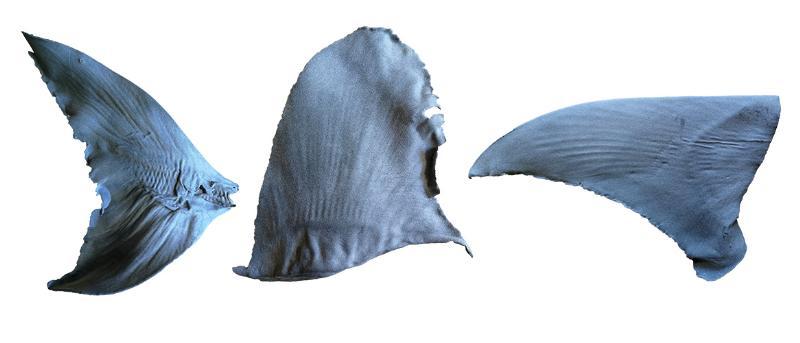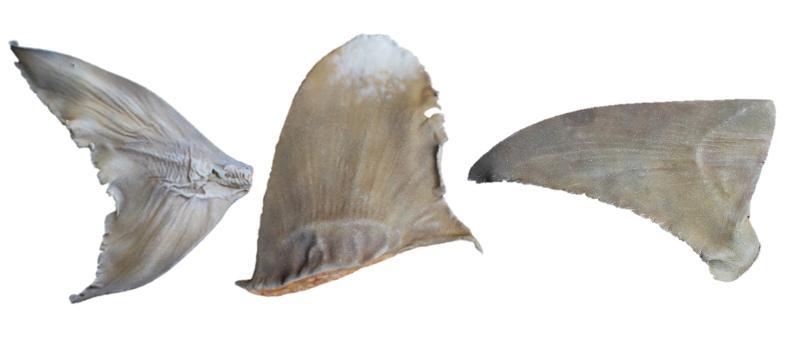
3D scan files of three of the shark fins we produced
i
THE NEED FOR SHARK FIN IDENTIFICATION
The illegal trade in shark fins is a global issue that is driven by the demand for shark fin soup - a delicacy and status food item in East Asia.
Sharks have been targeted for many centuries, mainly for their meat and fins, however, the fins are the most valuable part of many sharks and it is estimated that between 26 and 73 million sharks (worth USD 400-500 million) are traded each year1. The high economic incentives associated with the shark fin trade, combined with the demand for shark fin as a status food item and the poor enforcement at many points in the supply chain, are the main factors driving the illegal trade.
The fins of some species, such as Hammerhead sharks (Sphyrnidae spp.), and Oceanic Whitetip Carcharhinus longimanus are of higher value and the associated demand has contributed to unsustainable fishing pressure on the populations of these species. As a result, over 40 shark and ray species have been listed in Appendix II of the Convention on International Trade in Endangered Species of Wild Fauna and Flora (CITES). In order to export CITES-listed shark species, a permit must be issued by the exporting country’s CITES Management Authority confirming that the shipment was obtained legally and sustainably, and that the catch and trade are not detrimental to the survival of the species. The illegal trade in CITES-listed species is of extra concern given the conservation reasons related to those species being added in the CITES Appendices.
Shark fins including from Bigeye Thresher Sharks in trade. Photo: Markus Bürgener
i
development of 3d replica shark fins
During discussions with TRAFFIC on shark fin training, the Shark Scientist, Charlene da Silva, at the South African Department of Forestry, Fisheries and Environment (DFFE) suggested making 3D printed fins, based on real dried shark fins. Funding was sourced to conduct the necessary research and development process through the TRAFFIC ReTTA project, funded by Arcadia—a charitable fund of Lisbet Rausing and Peter Baldwin.
The subsequent development of the 3D replica fins was a collaborative process involving many stakeholders from across the world.
Dried fins from CITES-listed sharks were collected over the years by Debra Abercrombie, a shark expert based in Florida, USA, who used them for training customs and fisheries officials across the world on the key identifying features of the fins. The fins from this and additional collections were 3D laser scanned to provide a digital representation of each fin.
Blue Shark fin (pectoral) are 3D laser scanned using 3D image software. Photo: Markus Bürgener
i
Once a digital representation of each fin was created, the 3D scanned images underwent a process known as retopology. This is a process whereby the 3D scanned image is modified to produce an optimally printed product. The retopologized shark files were then 3D printed using a selective laser sintering process with nylon as the main material. Sintered nylon provides a slightly rough sandpaper-like texture similar to real dried shark fins which also allows for better adhesion of paint.
For those looking to change the text on the fins by editing the digital files, please contact .
We also extend our sincere thanks to 3D Forms for their printing expertise.

The replica shark fins after 3D printing using sintered nylon as the main material for printing (Bowmouth Guitarfish (Rhina ancylostoma) caudal fin, Oceanic Whitetip Carcharhinus longimanus dorsal fin, and Great Hammerhead Sphyrna mokarran pectoral fin)
i
The painting of the replica fins served as the most challenging step in the process as it was essential for the final painted fins to have the correct colours and markings, as these are often important identifying features.
Skilled artists from Cosmesis Advanced Prosthetics, a company based in Cape Town, assisted with the painting of the replica fins. To ensure that the colours and markings on the painted fins most accurately matched those of the real fins, photographs were taken of the real fins with grey and colour reference cards. The final painted fins involved multiple layers of airbrushing to create the exact colour for each fin, with specific paint marking added depending on the fin and key identifying features – for example, white mottled markings for Oceanic Whitetip sharks.

Replica shark fins after painting (Bowmouth Guitarfish (Rhina ancylostoma) caudal fin, Oceanic Whitetip Carcharhinus longimanus dorsal fin, and Great Hammerhead Sphyrna mokarran pectoral fin)
i
Once the shark fins were scanned, printed and painted we realised that these fins would be great for training purposes but that replica fins being used by enforcement officials in active inspections should have the name of the shark and the type of fin, printed on each fin (eg: Oceanic Whitetip, dorsal).
With the assistance of Cosmesis Advanced Prosthetics, we also developed the concept of being able to provide a QR code-based link from each fin to dedicated web pages providing information on the key identifying features for each species. Accordingly, a second set of fin scans has been developed (through retopology) which provides printed fins that contain the name of each shark along the leading edge of the fin and a raised square section on which QR codes can be attached. With these fins, law enforcement officials can scan the QR codes on their phone and obtain detailed guidance on the key identification features of that specific fin. This combination of replica fins and guidance on key identifying features is expected to give law enforcement the best combination of shark fin identification tools, allowing for rapid and confident decision-making.

